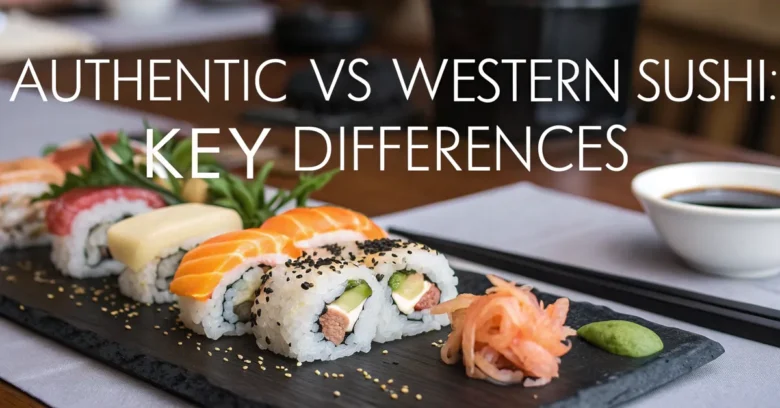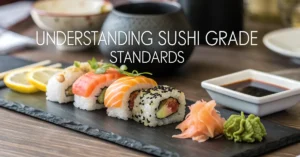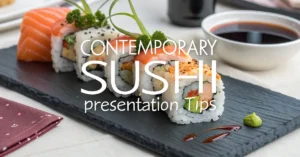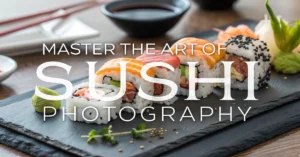Sushi. The word conjures images of delicate rolls, vibrant colors, and the freshest seafood. But what you might not know is that what you picture as sushi might be very different depending on where you are in the world. From meticulously crafted Edomae-style creations in Tokyo to the inventive and often extravagant rolls found in your local Western sushi restaurant, there’s a whole world of difference in sushi types to explore.
This article peels back the nori to uncover the key distinctions between authentic and Western sushi. We’ll explore the traditions, ingredients, and techniques that define each style, so you can better appreciate the art of sushi. Ready to dive in?
Authentic vs Western Sushi: Key Differences
Authentic sushi, rooted in Japanese tradition, focuses on simplicity and highlighting the natural flavors of the ingredients. Western sushi, on the other hand, often embraces innovation and caters to local palates with creative combinations and sauces. Here’s a detailed breakdown of their key differences:
Ingredients: A Tale of Two Palates
- Rice: In both styles, rice is paramount. Authentic sushi uses sushi meshi, short-grain Japanese rice seasoned with vinegar, sugar, and salt. The preparation is precise, aiming for a slightly firm texture. Western sushi also employs sushi meshi, but the seasoning might be sweeter or less acidic to suit local tastes.
- Seafood: Authentic sushi emphasizes fresh, seasonal seafood. The focus is on the quality and natural taste of the fish. Common choices include tuna, salmon, yellowtail, and eel. Western sushi also uses these, but may include a wider range of seafood and even cooked options like shrimp tempura or imitation crab.
- Nori (Seaweed): Both types use nori, the dried seaweed sheets used for rolling. However, authentic sushi places a premium on high-quality nori that is crisp, flavorful, and melts in your mouth. Western sushi may use less expensive nori that can be chewier.
- Fillings: This is where the divergence becomes most apparent. Authentic sushi typically features a limited number of fillings, allowing the seafood to shine. Classic choices include wasabi, ginger, cucumber, and avocado (though avocado is a relatively recent addition). Western sushi embraces a more liberal approach with a vast array of fillings like cream cheese, spicy mayonnaise, various sauces, and even cooked meats.
Preparation Techniques: Tradition vs. Innovation
- Nigiri: This quintessential sushi consists of a slice of fish draped over a hand-formed mound of rice. Authentic nigiri showcases the chef’s skill in selecting and preparing the fish and rice, while Western nigiri may use different fish or add sauces.
- Maki (Rolls): Maki are rolls made with rice, fillings, and nori. Authentic maki are typically simple, such as hosomaki (thin rolls with one filling) or futomaki (thick rolls with multiple fillings). Western maki, often called “specialty rolls,” are more elaborate, incorporating many ingredients and sauces.
- Presentation: Authentic sushi presentation is minimalist, emphasizing the natural beauty of the ingredients. The focus is on clean lines and a harmonious arrangement. Western sushi presentation can be more elaborate, with colorful sauces, garnishes, and intricate designs.
Taste and Flavor Profiles: Simplicity vs. Complexity
- Authentic Sushi: The flavor profile prioritizes the natural taste of the fish and the subtle tang of the rice vinegar. Wasabi and soy sauce are used sparingly to enhance, not mask, the flavors. The goal is a balanced and refined taste.
- Western Sushi: The flavor profile is often bolder and more complex. Sauces like spicy mayo, teriyaki, and eel sauce add sweetness, spice, and richness. The combination of numerous ingredients creates a more layered and intense taste experience.
Diving Deeper: Unpacking Authentic Sushi
Authentic sushi, also known as Edomae sushi, originated in Tokyo (formerly Edo) during the 19th century. Here’s a closer look at the elements that define it:
The Art of Sushi Meshi
The quality of the rice is the foundation of authentic sushi. Sushi meshi is prepared with meticulous care, following these steps:
- Selection: Short-grain Japanese rice is chosen for its stickiness and ability to absorb the vinegar mixture.
- Washing: The rice is washed repeatedly to remove excess starch, resulting in a cleaner flavor.
- Cooking: The rice is cooked to the perfect consistency – firm but not hard.
- Seasoning: The cooked rice is mixed with sushi-zu, a blend of rice vinegar, sugar, and salt. The ratio of these ingredients varies depending on the chef’s preference.
- Cooling: The seasoned rice is cooled to body temperature while being gently folded to distribute the vinegar evenly.
The Importance of Fresh, Seasonal Seafood
Authentic sushi chefs prioritize using the freshest, highest-quality seafood available. They often source their fish directly from local markets or trusted suppliers. Seasonal fish are particularly prized for their optimal flavor and texture.
Mastering Traditional Cutting Techniques
The way the fish is cut plays a crucial role in the taste and texture of the sushi. Authentic sushi chefs undergo years of training to master various cutting techniques, such as:
- Hira-zukuri: A rectangular cut used for firm-fleshed fish like tuna.
- Usu-zukuri: A thin, sliced cut used for delicate fish like flounder.
- Sogi-giri: A diagonal slice used to maximize the surface area of the fish.
Minimalist Presentation
Authentic sushi presentation is an art form in itself. The goal is to showcase the natural beauty of the ingredients and create a sense of harmony. Sushi is typically arranged on a simple plate or wooden board, with minimal garnishes.
Exploring Western Sushi: Innovation and Adaptation
Western sushi emerged in the United States in the 1960s and has since evolved into a distinct style that caters to local preferences.
The California Roll: A Pioneer of Western Sushi
The California roll, invented in Los Angeles in the 1970s, is widely credited as the dish that popularized sushi in the West. It features avocado, cucumber, and imitation crab rolled inside out (rice on the outside). Its mild flavors and approachable ingredients made it an instant hit.
The Rise of Specialty Rolls: A Creative Explosion
Following the success of the California roll, Western sushi chefs began experimenting with a wider range of ingredients and flavor combinations. This led to the creation of countless “specialty rolls,” each with its unique name and combination of fillings.
Embracing Sauces and Toppings
Western sushi often incorporates a variety of sauces and toppings to enhance the flavor and visual appeal of the rolls. Popular choices include:
- Spicy Mayonnaise: A blend of mayonnaise and chili sauce.
- Eel Sauce: A sweet and savory sauce made from soy sauce, mirin, and sugar.
- Teriyaki Sauce: A sweet and tangy sauce made from soy sauce, sake, mirin, and sugar.
- Tempura Flakes: Crispy bits of fried batter.
- Sesame Seeds: A sprinkle of nutty flavor and texture.
Adapting to Local Tastes
Western sushi has adapted to local tastes in different regions. For example, in some areas, you might find rolls with ingredients like steak, chicken, or even deep-fried vegetables.
The Pros and Cons of Each Style
Both authentic and Western sushi offer unique culinary experiences. Here’s a balanced look at their advantages and disadvantages:
Authentic Sushi: A Refined Experience
Pros:
- Focus on Quality: Emphasizes fresh, high-quality ingredients.
- Subtle Flavors: Highlights the natural taste of the seafood and rice.
- Artistic Presentation: Showcases minimalist beauty and attention to detail.
- Healthier Option: Generally lower in calories and fat compared to Western sushi.
Cons:
- Acquired Taste: The subtle flavors may not appeal to everyone.
- Limited Variety: The focus on traditional ingredients can limit the range of options.
- Higher Price Point: The use of high-quality ingredients and skilled preparation can make it more expensive.
Western Sushi: A Bold and Accessible Option
Pros:
- Wide Appeal: The bold flavors and creative combinations appeal to a broader range of palates.
- Extensive Variety: Offers a vast array of options to suit different tastes and preferences.
- More Affordable: The use of less expensive ingredients can make it more accessible.
Cons:
- Compromised Quality: The focus on quantity and variety can sometimes compromise the quality of the ingredients.
- Overpowering Flavors: The use of sauces and toppings can mask the natural taste of the fish.
- Less Healthy: Often higher in calories, fat, and sodium due to the use of sauces and fried ingredients.
- Authenticity Concerns: May not accurately represent the traditional art of sushi.
The Importance of Knowing Your Sushi Types
Understanding the nuances of authentic versus Western sushi allows you to make informed choices and appreciate the unique qualities of each style. Whether you prefer the refined simplicity of Edomae sushi or the bold innovation of Western sushi, there’s a world of deliciousness to explore.
Beyond the Basics: A World of Sushi Variations
The world of sushi extends far beyond the basic nigiri and maki. Here are some other sushi types you might encounter:
- Chirashi: A bowl of sushi rice topped with a variety of seafood and other ingredients.
- Inari: Fried tofu pouches filled with sushi rice.
- Oshizushi: Pressed sushi made in a wooden mold.
- Temaki: Hand-rolled cones of nori filled with rice and other ingredients.
- Narezushi: Fermented sushi, an ancient method of preserving fish with rice.
Ordering Sushi Like a Pro
Navigating a sushi menu can be daunting, especially with the abundance of options available. Here are some tips for ordering sushi like a seasoned pro:
Understanding Sushi Terminology
Familiarize yourself with common sushi terms to make informed choices:
- Nigiri: Hand-formed sushi with a slice of fish on top.
- Sashimi: Slices of raw fish served without rice.
- Maki: Rolls made with rice, fillings, and nori.
- Temaki: Hand-rolled cones of nori.
- Uramaki: Inside-out rolls with rice on the outside.
- Hosomaki: Thin rolls with one filling.
- Futomaki: Thick rolls with multiple fillings.
- Gunkanmaki: Battleship rolls with nori walls filled with ingredients.
Asking the Right Questions
Don’t hesitate to ask your server questions about the sushi:
- What is the freshest fish available today?
- Do you have any seasonal specials?
- What is your chef’s recommendation?
- Can you tell me more about the ingredients in this roll?
Starting Simple
If you’re new to sushi, start with milder options like salmon or cooked shrimp nigiri or a California roll. As you become more adventurous, you can explore different types of fish and more complex rolls.
Considering Your Dietary Restrictions
Sushi can be adapted to accommodate various dietary restrictions:
- Vegetarian/Vegan: Opt for rolls with vegetables, tofu, or avocado.
- Gluten-Free: Request gluten-free soy sauce (tamari) and avoid rolls with tempura or sauces that contain gluten.
- Shellfish Allergy: Inform your server about your allergy and avoid rolls with shrimp, crab, or other shellfish.
The Future of Sushi: A Culinary Crossroads
The world of sushi continues to evolve, with chefs pushing boundaries and experimenting with new ingredients and techniques. Here are some trends to watch:
Sustainable Sushi
As awareness of environmental issues grows, sustainable sushi is gaining popularity. This involves using fish from responsibly managed fisheries and reducing waste.
Plant-Based Sushi
With the rise of veganism, plant-based sushi is becoming increasingly common. Chefs are using innovative ingredients like marinated tomatoes, eggplant, and mushrooms to create delicious and satisfying vegan sushi options.
Fusion Sushi
Fusion sushi blends elements of different cuisines to create unique and exciting flavor combinations. You might find sushi with Latin American, Asian, or even Italian influences.
Appreciating the Journey of Sushi
Whether you’re a seasoned sushi aficionado or a curious newcomer, understanding the distinctions between authentic and Western sushi allows you to appreciate the journey of this iconic dish. From its humble beginnings as a method of preserving fish to its current status as a global culinary phenomenon, sushi continues to captivate and delight palates around the world.
So, the next time you find yourself at a sushi bar, take a moment to consider the traditions, techniques, and ingredients that make each roll unique. Embrace the simplicity of authentic sushi or the bold creativity of Western sushi. And most importantly, enjoy the delicious and satisfying experience that sushi has to offer. After all, the best sushi is the kind that you enjoy the most. So, experiment and find the sushi types that you love. Then, let your taste buds guide you!



